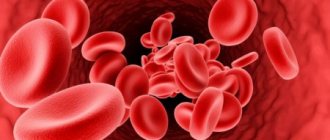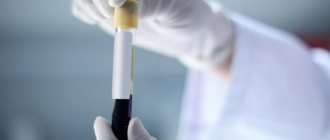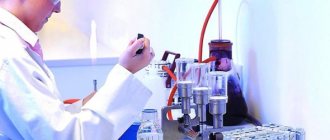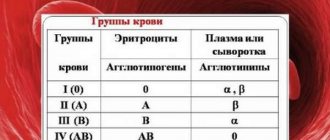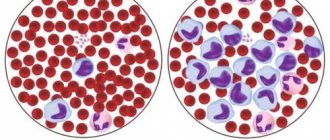Blood transfusion is a common and effective treatment method. If there is not enough of this biological fluid in the body, or it has acquired pathological properties, death may occur. Therefore, donors are needed to save lives and fight serious diseases. Thanks to blood transfusions, doctors have successfully saved the lives of thousands of people. Blood transfusion has been used since the middle of the last century.
Blood transfusion is a procedure for which doctors must carefully prepare so as not to harm the patient. If the blood of the donor and recipient are incompatible, it will lead to serious problems and even death.
If you mix different groups, an agglutination reaction occurs, when red blood cells stick together and no longer perform their functions, or antibodies are released in the recipient's body and destroy foreign cells.
To classify blood, the AB0 system is used (by groups). According to it, there are only four groups: the first is 0, the second is designated by the Latin letter A, the third is B and the fourth is marked by two letters - AB.
There are only two types of Rh factor: positive and negative. Based on this, 8 combinations of blood types are distinguished. The question often arises, which blood group is the most popular for donation?
It’s worth clarifying right away that there is universal blood that suits everyone; it is safe to transfuse to any person. It is common, so it is not considered the most popular in donation. And there is blood, the carriers of which are very few on Earth; it is considered rare.
Blood type and Rh factor, let's take a closer look
What do the blood group and Rh factor designations mean? The combination of antigens in red blood cells and blood plasma determines the group. It never changes in humans, since the set of proteins in cells is always the same.
Scientists have compiled several classifications of blood; they appeared because there are many antigens on the cells that form antigen systems. In practice, only one AB0 classification is used.
There are three types of antigens on human red blood cells: H - inactive, A, B and AB - active. These Latin letters encrypt groups. Only instead of the letter H they write the number 0 for convenience, which means that there are no antigens. Next to the letter designation they write I, II, III or IV. Using these Latin numbers, people can understand what blood type is encrypted.
In addition, there is a special protein in the blood called agglutinin. It is denoted by two Greek letters - beta and alpha. It is this that leads to the destruction of red blood cells if they carry a mismatched set of proteins. This happens when a blood type that is different from that of the recipient enters the body.
Based on this, it is clear that there is a specific combination of antigens and agglutinins by which the blood type is determined. The second group contains antigen A and agglutinin beta. In the third, on the contrary, B and alpha. In the first group there are both agglutinins, since there are no antigens. Plasma of the fourth group contains A and B antigens, so there are no agglutinins.
Plasma and formed elements with the same set of proteins are considered compatible. Only then will it take root in the recipient’s body after the transfusion.
Human blood has a constant Rh factor, it is written as Rh, + or depending on whether it is positive or negative. The Rh factor is also determined by the presence of antigens on the surface of red blood cells. There are 6 proteins that encode the Rh factor. If the cells have protein D, or C+E, then the blood is Rh+. If these antigens are not present – Rh-.
This indicator is also used to determine whether it is safe to do a transfusion or not. But if the situation is critical, it is permissible to mix positive and negative Rhesus.
2nd group
A (II) group is limited to possible recipients, since it is suitable only for owners of A (II) and AB (IV) with the presence and absence of antigen with a negative Rh factor. According to its structure, it contains two types of agglutinogens, and therefore it is suitable for only two types. If the second (+) is used for transfusion, then the recipient must also have a positive group. When a transfusion is necessary for a patient with A (II) Rh +, any first or second blood group will suit him. With (—) factor, it is possible to use only the same blood without antigen, as well as 0(I).
Which group is the most common?
Which blood is most in demand in medicine for donation, rare or common? let's figure it out.
Based on statistics, we note that the first group is most common. Approximately half of the entire population of the planet is its carrier. C II (A) – 40% of the population. Only 9% of people are in the third group, and 4% are in the fourth. The vast majority (85%) have Rh+. And only 15% have a Rh negative factor.
We conclude that there are more people with I(0) Rh+ blood, which is why it is the most common. IV (AB) Rh- is considered the rarest. Sometimes it is very necessary, so it is collected and stored in special jars where it can be purchased. You can find out how much blood type 4 costs at a bank or from a doctor.
Person's character
People with blood type 4 and Rh positive have character traits such as kindness and responsiveness. They are prone to creative thinking, emotional and sometimes too vulnerable. At the same time, they are completely unforgiving and very quickly forgive even deep grievances. People with positive blood type 4 have good intuition and rich imagination. This kind of blood flows in the veins of many psychics, fortune tellers and fortune tellers.
Negative personality traits include indiscipline, lack of concentration and lack of determination. Coupled with innate curiosity, these qualities make a person with 4+ blood a keen nature, falling in love (with people or activities), but quickly cooling down towards objects of passion.
Often, the self-esteem of people with blood group 4Rh+ is significantly underestimated. Because of this, they tend to constantly delve into themselves, looking for shortcomings, and worry about even the most insignificant reasons. At the same time, they romanticize the surrounding reality and firmly believe in universal justice and balance.
People with positive blood type 4 have good intuition and rich imagination.
People with blood type 4+ are very receptive and suggestible, trusting, flexible and gentle towards others. They can easily fall under the influence of deceivers and manipulators. Among such people there are many religious fanatics and irreconcilable and uncompromising fighters for anything (for animal rights, for the freedom of Tibet, and so on).
Holders of positive blood type 4 are creatively gifted and most often choose the appropriate professions: they become musicians, writers, poets or philosophers. This is due to the fact that the spiritual world is much more important to them than the material, earthly one.
Does universal mean the best?
There are universal donors - these are people with the first group. This is because there are no antigen proteins on their red blood cells, so the recipient’s body does not perceive it as foreign and does not produce antibodies that destroy the infused cells. Due to its versatility, the first group is considered the best.
And blood types with A and B proteins can only be infused into people with the same set. There is also a universal recipient - a person with the fourth group. His body will accept any set of antigens.
However, the above rules do not apply in practical medicine. Today it is forbidden to mix different groups and Rh factors. Therefore, both the donor and the recipient must have the same set of proteins. Exceptions are made only in emergency cases.
And yet, which group is the most popular?
Based on the information provided, two conclusions arise:
- The most in demand blood group is I (0) Rh+, since the vast majority of people have this group.
- There are much fewer IV (AB) Rh positive and negative ones, which is why it is more difficult to find. This is because there are very few people with such blood flowing in their veins. And if the patient has to undergo a transfusion, it will be difficult to find a donor.
We can say that the most popular blood group for donation is the fourth, since it is the least of all on the planet.
Pregnancy
At the stage of pregnancy planning, all women must undergo certain preparatory procedures, regardless of blood type. It is necessary to improve the body’s health, cure acute diseases, and take preventive measures to strengthen the immune system. For those with blood group 4, this is especially important, because the resistance of their immune system to infections is lower than that of other women.
For pregnant women with blood group 4Rh+, there are no specific restrictions or lifestyle recommendations. You just need to adhere to generally accepted rules: eat well, get enough sleep if possible, don’t burden yourself with household chores, get more rest and be in a positive mood. Statistics show that women with positive blood group 4 are more likely to experience toxicosis (perhaps this is due to reduced immunity and a sensitive gastrointestinal tract system). You can get rid of nausea, vomiting, gas, heartburn and other unpleasant phenomena with water acidified with lemon juice, black bread crackers and frequent walks in the fresh air. The attending physician will adjust the diet, but generally, while carrying a child, a woman can eat whatever she wants, even if it is not the healthiest food, and refuse foods that cause disgust.
Among the advantages characteristic of pregnant women with 4Rh+, it is important to highlight the low risk of Rh conflict. Even if the father of the unborn baby has a negative Rh factor, which will be inherited by the fetus, the likelihood of developing a Rh conflict is very low.
People with 4Rh+ blood are talented and romantic, sometimes they can be touchy, but they always quickly let go of everything bad. Their character is contradictory, but this is their uniqueness, and this is why they arouse interest. As for health, it all depends on themselves. If you lead a correct lifestyle and follow a suitable diet, there will be no difficulties with your health.
In what cases is blood transfusion required?
Transfusion is done due to severe blood loss. If the patient loses about 30% of blood within a few hours, then this procedure should be performed. It is also done urgently if a person is in shock after surgical treatment.
Transfusions are often prescribed to patients who have been diagnosed with anemia, serious blood diseases, inflammatory processes in the body and purulent-septic diseases, strong and severe intoxications of the body.
The procedure is prescribed to people with the following diseases:
- leukopenia – a sharp decrease in the level of leukocytes,
- hypoproteinemia – low level of protein in the blood,
- sepsis - infection of the blood by microbes,
- violation of ESR.
For transfusion, blood with all its components, drugs and blood substitutes are mixed. Medicines are added to the donor’s normal blood to increase the therapeutic effect, while reducing the risk of complications after the procedure.
Red blood cells are often injected into the patient's body. To do this, the red blood cells are first separated from the frozen plasma. After this, a liquid with a high concentration of red cells is poured into the recipient’s body. This method is used for anemia, acute blood loss, with the development of malignant tumors, after tissue and organ transplantation.
A mass of leukocytes is infused for agranulocytosis, when the level of these cells rapidly decreases, and for the treatment of severe complications of diseases of an infectious nature. After the procedure, the level of white cells in the blood increases, which has a beneficial effect on the course of recovery.
When to use fresh frozen plasma:
- severe blood loss,
- DIC syndrome,
- hemorrhages - blood leaks through damaged vessel walls,
- overdose of coagulants,
- diseases of an infectious nature.
Patients with blood diseases especially need transfusions. Some patients have to do this procedure once a week, or even more often.
Transfusions are also given to people after chemotherapy. If the tumor has affected the bone marrow, after therapy not only malignant cells stop growing, but also healthy ones.
Women often need transfusions after a difficult birth during which they lost a lot of blood. Sometimes doctors do not recommend using a man's blood for this. Women's is considered safer, and for a young mother this is especially important.
Heredity
When a new life is born, it depends only on the parents what blood type the baby will receive. An important role is played by the compatibility of parents during conception and pregnancy. The fact is that the genes of the mother and father are equally involved in the creation of a new person. The blood type in itself does not matter, and when different groups are combined, the child will receive either the blood of the mother or the father, or, through the process of mutation, a different type.
But with different Rh factors, an immune reaction occurs. If the child has the antigen, but the mother does not, a Rh conflict occurs. Agglutinins are produced and proteins are destroyed. When positive and negative red blood cells meet again, a reaction of gluing and destruction of hematopoietic cells occurs.
Rh factor value
When transfusion occurs, it is necessary to take into account the blood group of the recipient and donor, as well as their Rh factor.
Even if the type is the same, then different Rh factors are a contraindication to the procedure:
- I can only accept the same group.
- II can accept both its own and I.
- III fits I and III.
- IV accepts all other types.
Which group is right for everyone? This plate shows that the universal group is the first. It is this that can be transfused to a carrier of any other blood. However, for those who have the first type, only a person with the same group can act as a donor.
Despite its versatility, before infusing biomaterial, it is necessary to take into account the Rh factor. In case of incompatibility, a strong release of antibodies may occur, which will lead to blood clotting, which means the death of a living organism.
So, the first group can be transfused to everyone. It is considered the most common, so its supplies are usually found in sufficient quantities in medical institutions.
The blood type is suitable for everyone: compatibility and facts about blood, the universality of the group
Blood transfusions (the medical term is blood transfusion) have already saved many lives. Those who donate blood are called donors, and those who receive it are called recipients.
Before carrying out medical manipulation, compatibility tests are carried out.
But even when using the 1st positive blood group, which is suitable for everyone, a full examination of the victim is required. This is a guarantee of health and life safety.
Why know your blood type
The physiological fluid that distributes oxygen and nutrients throughout the body and utilizes waste products of cells is not homogeneous in composition.
It includes red blood cells, white blood cells, platelets and plasma. In addition, several blood groups are distinguished and classified according to the Rh factor, a specific antigen.
If the indicators do not match, the transfusion causes rejection and leads to the death of the recipient.
For most adults, a stamp with the main parameters - group and Rh factor - is placed in the passport and on the first page of the medical card. But when entering the hospital, a compatibility test is required.
This must be done to eliminate Rhesus conflict. Compatibility is checked not only when transfusion is necessary, but also when planning pregnancy. There is an opinion that it is better when sexual partners have the same parameters. But it's not right.
All groups of physiological fluid are suitable for each other.
Unfavorable conditions for gestation occur when Rhesus mismatches occur, but not in all cases. For example, during the first pregnancy, only 98% of women experience problems. But when you conceive again with the same partner, antigens begin to be produced - the immune system has managed to “remember the aggressor.”
To prevent Rhesus conflict, it is necessary to register as early as possible. Especially when a woman’s status is negative, and a man’s status is positive. It is dangerous when there is a discrepancy in these parameters between the mother’s body and the fetus. Sometimes treatment is required at the planning stage. Incompatibility of Rh factors makes it difficult to conceive.
Even 40-50 years ago it was believed that the first blood group was suitable for everyone. Plasma and red blood cell transfusions are now being carried out.
If these parameters do not match, the immune system begins to produce antibodies that destroy blood cells.
Based on the parameters of physiological fluid, it is possible to predict the course of pregnancy, determine the compatibility of a child with future parents, and diagnose oncological processes at an early stage.
Rh factor
This important parameter determines the specific protein that enters the red blood cells and is located on the surface. If it is isolated, the Rh factor is positive, dominant; if it fails, it is negative, recessive. The indicator cannot be changed - it is inherited.
Antigens D, C, c, E, e have immunogenic properties, and if transfusion is necessary, the properties of the Rho(D) antigen are examined, which is most clearly responsible for the conflict between the physiological fluids of the donor and recipient. The composition of blood is complex, it contains 59 antigens and more than 200 alleys (different forms of the same gene that determine specific characteristics).
Compatibility
Testing for combinations in groups began to be carried out relatively recently - only in the middle of the twentieth century. The blood is considered suitable if agglutination does not develop. That is, the donor's red blood cells are not destroyed under the influence of antigens produced by the recipient's circulatory system. This manifests itself as sedimentation and disruption of the structure of formed elements.
The sedimentation reaction begins when the same agglutinogens and agglutinins are combined. The viscosity of the physiological fluid increases, and the rate of coagulation increases. Due to the clumping of platelets, blood flow slows down, tissues and organs lack oxygen.
The purpose of the transfusion: restoration to the original volume, renewal of the formed elements and composition of the blood, normalization of osmotic pressure. Before starting the procedure, compatibility tests are carried out.
Table defining the compatibility of parameters between donor and recipient:
| Recipient | Donor | |||||
| 01 (+) | 2 (+) | 2(-) | 3(+) | 3(-) | 4(+) | 4(-) |
| 01(+) | + | + | ||||
| 01(-) | + | |||||
| 2(+) | + | + | + | + | ||
| 2(-) | + | + | ||||
| 3(+) | + | + | + | |||
| 3(-) | + | + | ||||
| 4(+) | + | + | + | + | ||
| 4(-) | + | + | + | + |
Universal type
According to one theory of human origins, primitive people had 1 group. At that time, travel was limited to the area around the camp, the nature of the diet was monotonous - meat. Therefore, when creating diets, it is recommended to focus on protein foods. In addition, such people are considered the most vulnerable to viruses and bacteria.
Donors with the first positive blood group are considered universal. In emergency cases, transfusions are performed, regardless of rhesus. True, in a volume of no more than 500 ml. If the factor is negative, then blood transfusion is performed only in recipients with the corresponding parameter.
But if a person with group 1 has suffered, the possibilities of donation are limited. No other type is suitable. There is a theory that the number of “descendants of ancient hunters” is constantly decreasing. Perhaps the time will come when physiological fluid will have to be synthesized artificially to replenish blood loss.
II (+ -)
According to scientific theory, it is believed that recipients with this type arose at the stage when agriculture appeared. Therefore, when switching to a healthy diet, such people should create a menu based on carbohydrates.
Donors of this type are suitable for owners of antigens A 2 and IV with AB, but only if the Rh factor matches. If blood transfusion is necessary, 1 group can be infused. The choice is wider than with therapeutic intervention for the descendants of the first hunters.
III (+ -)
This type of physiological fluid is more typical for residents of Africa, Korea, India and China. But in the USA, according to recent studies, only 10% of the world's inhabitants have it.
The origin story is more recent. The reason for the transformation is considered to be a change in the nature of food and living conditions. Tribes began to move around and explore new territories.
The diet has become more varied due to fermented milk products.
As a donor, holders of group 3 are suitable for their classification, taking into account the Rh factor. Can also be used for AB (IV) recipients.
Fourth group
This rare type is the most recent to appear and is now found in only 5% of the world's population. According to the theory, the impetus for changes in the characteristics of physiological fluid was mixed marriages and climate change. Features of the composition - increased amount of cortisol, a steroid hormone. This component makes it easier to endure physical activity.
Group 4 is the easiest time to find a donor. If Rh is positive, there is absolute compatibility with any carrier.
Methods for determining compatibility
Even if all tests for the group and Rh factor have been passed, biocompatibility tests must be carried out before transfusion. If the samples are negative, then they look for physiological material from another donor.
- Group test. Whey is used, separated using a centrifuge or, if there is time, settling. The recipient material is combined with the donor material in a 2:1 ratio. Rock the test tube in your hand, mixing the physiological fluids, for 5 minutes. A centrifuge is not used. If the agglutination reaction is negative - that is, no precipitate forms - compatibility has been proven.
- Rh factor test. 2 drops of the patient’s serum are dropped into the test tube, then 1 drop of the donor’s blood, and 1 drop of polyglucin, 33%. Stir for 5 minutes, so that it spreads over the walls, after 5 minutes, pour in 3 ml of saline solution and repeat shaking the container. There is no sticking or sedimentation, you can start blood transfusion.
Another type of research is using a Petri dish (a glass vessel in the shape of a flat cylinder with a hermetically sealed lid). The composition for the test is the same as when determining compatibility in a test tube, but without additional components. The Petri dish is placed in a water bath and heated for 10 minutes to 45-47°C. The appearance of agglutination indicates a conflict.
If laboratory testing is unavailable for some reason, a bioassay may be performed. Intravenously, by stream, an infusion of donor material is carried out in an amount of 10-15 ml. You can choose from red blood cell mass or suspension, or plasma. Conclusions are made based on the clinical picture.
Symptoms indicating incompatibility:
- dyspnea;
- increase or decrease in blood pressure;
- increased heart rate;
- redness or pallor of the skin;
- painful sensations in the kidney area and behind the sternum;
- spasms in the head;
- chills or fever.
The patient is observed for 3 minutes and, if there are no warning signs, testing is repeated up to 2 more times. Transfusion begins if compatibility is confirmed 3 times.
The consequences of incompatibility are quite serious. If the groups do not match, dangerous symptoms develop. Blood viscosity increases and metabolism is disrupted.
The patient begins to choke, the temperature first rises sharply, and then decreases.
Transfusion shock occurs directly during or after a transfusion. If the onset is delayed and medical attention is delayed, death is possible. At the same time, a coagulation disorder is noted.
Symptoms: internal bleeding or increased bleeding, hemorrhagic shock. If there is an error with Rh factors, liver and kidney failure develop. You should not be offended even when, despite the mark in your passport or card, the tests are repeated.
The consequences of an error are dangerous to the lives of patients, and the attending physician bears responsibility.
Source: https://krovinfo.com/kakaya-gruppa-krovi-podxodit-vsem/
